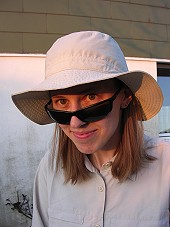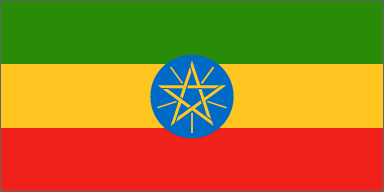
MARTINA'S WORLD TRIP
ETHIOPIA: May 18 - June 1, 2004


(Übersetzungshilfe)
 |
MARTINA'S WORLD TRIP ETHIOPIA: May 18 - June 1, 2004 |
|||||||
 |
||||||||
 |
Your Dictionary
(Übersetzungshilfe) |
|||||||
| Tuesday, May 25th, 2004 - Omo Valley Tour IV | ||||||
| Tuesday, May 25th, 2004 Omo Valley Tour Day IV (via Key Afar to Jinka)
Again an early morning. We packed up our tents and went over to the restaurant for breakfast. Oh, did I mention that there was a wasp nest inside the shower and that I actually survived taking my showers WITH wasps inside the little shower cabin??? Yes Mama, be proud of me!! This was our last meal at the restaurant and I wasn’t sure whether to regret or be thankful for it. As I said earlier on, the food was good but the selection very limited - even more so for a vegetarian. My breakfast usually consisted of scrambled eggs, whereas we learned that this was a dish prepared for tourists only as Ethiopians do not eat eggs because they think it’s disgusting. Maybe I should mention a few words about traditional Ethiopian food, although one single word would do the job: injera. Injera is the national staple, serving as the base of every meal. Spread out like a large, thin pancake, additional food is simply heaped on top of it. Injera is neither fried nor baked, it is merely the result of a fermentation process and therefore has a slightly sour taste you need to get used to. Occasionally, injera is rolled up beside the food or on a separate plate. To eat, you simply tear off a piece of injera with your right hand and wrap it around the food served with it. It is actually very important to use the right hand, as the left is supposed to be reserved for personal hygiene and therefore it is ‘unclean’ and not suitable to eat with. In order to illustrate the benefits of injera as a main ingredient for Ethiopian cuisine, here is what Lonely Planet has to say about it: However rude you are about injera, it does its job. Slightly bitter, it goes well with spicy food. Like bread, it’s filling; and like a pancake, it’s good for wrapping around small pieces of food and mopping up juices. It’s also easier to manipulate than rice and it doesn’t fall apart like bread – quite a clever invention, really. And no need for plates or cutlery either (or napkins or tablecloths). Although at first sight all injera may look like old grey kitchen flannel, grades and nuances do exist. (…) Low-quality injera is traditionally dark, coarse and sometimes very thick. Good-quality injera is pale (the paler the better), regular in thickness, smooth and always made with the indigenous Ethiopian cereal ‘tef’.” Now, what do Ethiopians eat with injera? Wat. According to my guidebook, it resembles a meat stew minus the vegetables, which I find a quite good description. It is basically a little heap of small meat pieces piled up in the middle of the injera on a huge plate. The meat can be lamp, beef or goat but as you can imagine, neither of those options were very appealing to me. Being a vegetarian in Ethiopia is almost as challenging as being a vegetarian in Asturias, although Ethiopia still has the advantage of so-called ‘fasting food’ that is usually available. Wednesdays and Fridays are traditional fasting days when no animal products should be eaten. Most restaurants, however, serve fasting food on any day. It usually consists of lentils, potatoes and cabbage, whereas the most popular fasting dish I came across was chick pee puree. This doesn’t sound too bad you may think and you are perfectly right if you think about ONE traditional fasting meal once in a while. But if this is the ONLY meal you get for breakfast, lunch and dinner, again and again, you might eventually get tired of it… this restaurant still had omelette and spaghetti on the menu, which added to a little variety for me, but at the end of this tour, I swear I couldn’t stand Ethiopian food anymore! Interestingly enough, the Swedish Red Cross lady had confirmed that Ethiopian children with hunger belly do not necessarily starve. She said they often have enough food but since many rural Ethiopians only eat meat and cereal-based dishes, totally neglecting fruits and vegetables (and I’ve seen many locals having injera with wat for breakfast, lunch and dinner), they often suffer from malnutrition, lack of vitamins and worm parasites causing children to have those well-known blown-up bellies. Back to today’s events. Saying good-bye to the Hamer people in Turmi was quite sad. Xavier, Mohamed and Ihab were all very popular amongst the children and I think they really got to like each other. Nevertheless, we had to take off and continue out tour towards Jinka, passing through the villages of Dimeka and Key Afar. Simply judging by the declining road conditions, we could tell that our tour had led us deeper and deeper into the Omo Valley. When we arrived in Jinka in the early afternoon, we were actually surprised to find a relatively civilised town in the middle of nowhere. Jinka serves as the administrative centre of the South Omo Zone. It even has an “airport” consisting of a grassy airstrip in the very city centre. We weren’t lucky enough to see a plane land but I could imagine that you pretty much need to duck when it approaches. We first checked in at our hotel, which turned out to be a positive surprise. Although a bit more expensive, we managed to leverage costs for all of us by sharing rooms. (Still, do not expect your shower to have warm water even if promised so by the reception.) At the hotel we also met Mahmush. He convinced us to hire him as our guide for a visit of an Ari village nearby. Ari and Banna are the two tribes mainly found in and around Jinka. The Ari have a population of around 120.000 people. They keep large numbers of livestock and produce large amounts of honey, often used for trade. Their traditional clothes include women’s skirts made from the enset tree (Baströcke). The Banna are believed to number around 45.000. Most practice agriculture, though their diet is supplemented by hunting. If they manage to kill a buffalo, they decorate themselves with clay and put on a special celebration and feast for the whole village. Although at first sceptic, we all agreed afterwards that it was one of the best village visits we’ve had. To get to the village, we had to walk about 4 km which was a nice little walk. Once we reached the village, we first went to see one of the village elders to ask for permission to visit. It was an old cheerful man who constantly kept making jokes that were apparently hard to translate. At least, we understood that he teasingly proposed Xavier, Mohamed and Ihab to marry some of his daughters and we didn’t really know how to react to that ‘joke’ without possibly insulting anyone! After clearance from the old man, we entered the village, first visiting a woman who was in charge of pottery. She showed us how new ceramic plates (the typical injera size) were dried in the sun before being heated over a fire. A bit further we met women crushing grains to actually produce injera. While strolling through the village, we had attracted the attention of the locals and especially the children, so by now at least 15 kids and youngsters followed us. Some of them offered us grilled corn and I think this was the one and only time in Ethiopia, we were not expected to pay for something. Otherwise, I am sorry to say that according to my experience, in this country no kind gesture is for free. I tried the corn but it was very dry and a little burned, so I guess I will stick to the Hamburger Dom version of grilled corn served with melted butter, pepper and salt… hmmm (you have no idea how tortured my stomach feels while I write this!). A little bit outside of the village, the local locksmith had his workshop. It was a man who turned out to be 30 years old but looked much older than that. He sat in the shade of a leafy roof on short pillars and was working a piece of metal over a small but very smoky fire. It was supposed to become a knife. We were watching him for about half an hour and judging by the minimal progress he made during this time, we could only imagine how long it would take him to actually finish a piece of work. While his one hand held a pair of pliers (= Zange) to keep the metal steady and the other was in command of the hammer, his foot rhythmically stepped on bellows (= Blasebalg) to maintain the fire. Right next to him, sat his 6-year old son who looked like maximum four. He as well was working a piece of metal, trying to manage the heavy hammer in his little hands. The locksmith proudly told us that one day his son would take over the business, so he needed to learn from an early age just as he had learned from his father. Seeing father and son working next to each other in what looked like perfect harmony, trying with every hammer slam to gain a little more power over a cold hard piece of metal, was a touching thing to see. Mahmush was an excellent guide, providing a lot of information. He could answer almost every question and if he couldn’t, he had no problem with saying that he didn’t know but he would always find out and tell us later. Thanks to him we learned that the coloured walls of the huts in the village were actually indicating that someone had died in this house within the last year. We were astonished that almost every hut was coloured but Mahmush explained that most families regularly loose someone to malaria. After the tour in the village we returned to Jinka and Mahmush brought us to a little weaver shop in town. We could see how the weaver produced beautiful white and coloured fabric on a traditional loom (=Webstuhl). Large rolls of beautifully patterned textile were on sale. Close by was the local market square and although the market was almost over at this time of the afternoon, we could get a glimpse of it and bought some fruits. This was also the first time we saw two women of the Mursi tribe that we were about to visit the next day. The Mursi are famous for their lip plates and very extraordinary body decoration. These two women, still quite young apparently, looked especially scary because they did not wear their lip plates, so that their lower lips were hanging loose, dangling below their chin when they spoke. Due to the plate insertion, they didn’t have their lower front teeth anymore, so nothing could control the saliva running down their chin. They were quite tall, had very short hair, white painted faces and carried a spear, which overall made them look quite impressive but dead ugly. This evening we had dinner at what was supposed to be the restaurant of the best hotel in town. Well, still quite simple and cheap, the food wasn’t bad but either the waiter had his first job ever or he was most likely slightly retarded! |
||||||